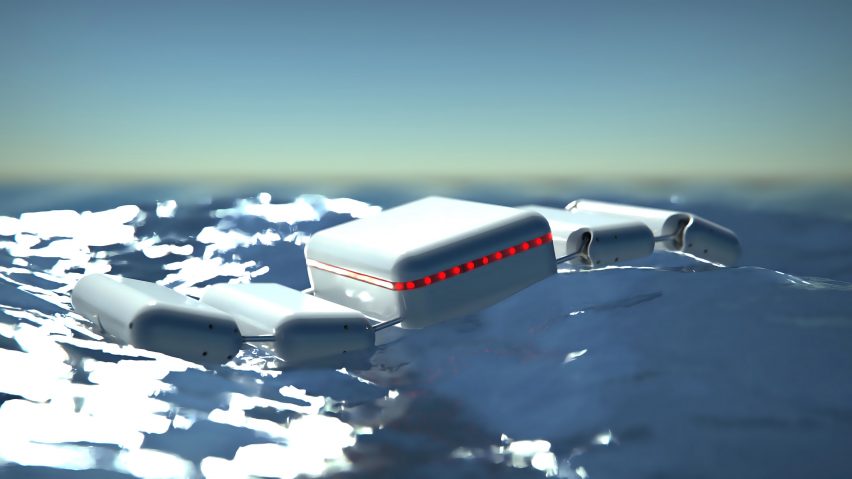Hawaii-based company WAVR has developed a prototype for a modular technology that floats on top of the ocean waves to gather energy from the motion of the water.
Called the WAVR Wave Energy Converter (WEC), the system uses a hinged floating device to constantly capture energy from the motion of the waves. It was developed for places such as Hawaii, with small landmasses and a significant connection to the ocean.
The initial prototypes have been developed to be used as stand-alone systems by consumers, such as boaters who can put the model into the water to generate energy to power small electric devices.
However, WAVR founder Clyde Igarashi told Dezeen that the idea is to partner with "larger institutions" in order to create wave farms that could potentially provide domestic energy for larger populations.
"Our idea is not to have one big one that gets powered by one large wave, but more like adding multiple units," he said.
"The modular design is smaller, probably more acceptable and easier to develop."
Partnering with manufacturing company Robogio Dynamics and with consultation from Russian engineer Victor Cheboxarov, Igarashi and his team developed a prototype that is made of 3D-printed plastic and weighs less than 10 pounds (4.5 kilograms).
The device uses motion from the waves captured through the hinges and stores it via an internal battery, and can also charge external battery packs.
While the design is currently limited to single models with wave energy harvesting technology, Igarashi hopes that the technology can be supported enough to also have wind and solar capacities.
Currently, the system generates about three watts of energy per square foot, which, according to Igarashi, is about one-fourth of the standard solar panel's current output.
However, Igarashi said that the primary benefits of the technology as a renewable energy option come from the constancy of the waves.
"You know, there are some places with virtually no sun and a lot of waves," he said.
The project was developed in line with the state of Hawaii's green energy goals, which seeks a 100 per cent renewable energy portfolio by 2045.
It has garnered the support of John Waihee, the former governor of the state, who is now an advisor to the company.
“Surrounded by the Pacific Ocean, Hawaii could greatly benefit from the rapid development of the WAVR technology," said Waihee.
"As one of the most isolated landmasses in the world, we can secure a more sustainable future by utilizing the natural resources around us."
"It would be a major step forward if wave energy can be harnessed along with other renewable energy technologies like solar and wind."
As of now, only individual units with wave energy technology have been produced. Igarashi noted that current wave energy technology is "too big to be practical" because they are large and rely on bigger waves, whereas the WAVR system relies on smaller waves that can be closer to the shoreline.
He believes his company's system presents a workable way forward.
"We feel confident that this is just the starting point," said Igarashi. "We expect to make advances as we upgrade components and constantly improve design."
Anchored by weights or connection to the ocean floor, the design could be used around existing wind farms, so as to minimise the amount of ocean space taken up by the units.
Other novel renewable energy technologies developed recently include a portable wind turbine developed by Aurea Technologies.
Project credits:
WAVR team: Giorgio Corrado, Walter Bozzetti, Clyde Igarashi, Mostafa Ali
Advisors: Victor Cheboxarov, John Waihee
Product developers: Robogio Dynamics

